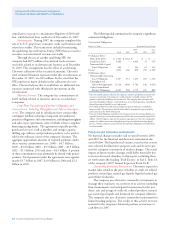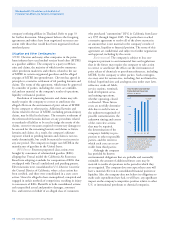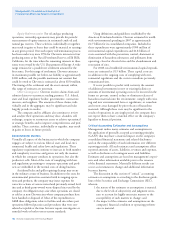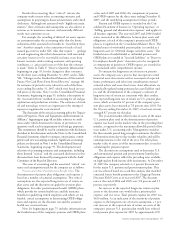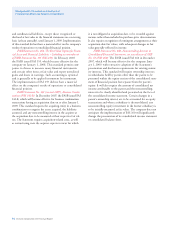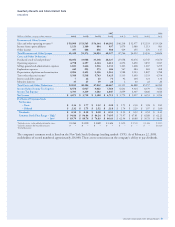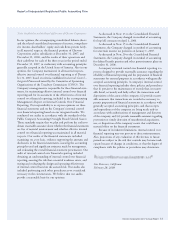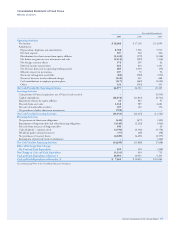Chevron 2007 Annual Report Download - page 51
Download and view the complete annual report
Please find page 51 of the 2007 Chevron annual report below. You can navigate through the pages in the report by either clicking on the pages listed below, or by using the keyword search tool below to find specific information within the annual report. 49
impairment when the fair value of the investment falls below
the company’s carrying value. When such a decline is deemed
to be other than temporary, an impairment charge is recorded
to the income statement for the difference between the
investment’s carrying value and its estimated fair value at the
time. In making the determination as to whether a decline is
other than temporary, the company considers such factors as
the duration and extent of the decline, the investee’s financial
performance, and the company’s ability and intention to
retain its investment for a period that will be sufficient to
allow for any anticipated recovery in the investment’s market
value. Differing assumptions could affect whether an invest-
ment is impaired in any period or the amount of the
impairment and are not subject to sensitivity analysis.
From time to time, the company performs impairment
reviews and determines that no write-down in the carrying
value of an asset or asset group is required. For example,
when significant downward revisions to crude oil and natural
gas reserves are made for any single field or concession, an
impairment review is performed to determine if the carrying
value of the asset remains recoverable. Also, if the expectation
of sale of a particular asset or asset group in any period has
been deemed more likely than not, an impairment review is
performed, and if the estimated net proceeds exceed the car-
rying value of the asset or asset group, no impairment charge
is required. Such calculations are reviewed each period until
the asset or asset group is disposed of. Assets that are not
impaired on a held-and-used basis could possibly become
impaired if a decision is made to sell such assets. That is, the
assets would be impaired if they are classified as held-for-sale
and the estimated proceeds from the sale, less costs to sell,
are less than the assets’ associated carrying values.
Business Combinations – Purchase-Price Allocation Ac-
counting for business combinations requires the allocation of
the company’s purchase price to the various assets and liabili-
ties of the acquired business at their respective fair values.
The company uses all available information to make these
fair value determinations, and for major acquisitions, may
hire an independent appraisal firm to assist in making fair
value estimates. In some instances, assumptions with respect
to the timing and amount of future revenues and expenses
associated with an asset might have to be used in determin-
ing its fair value. Actual timing and amount of net cash flows
from revenues and expenses related to that asset over time
may differ materially from those initial estimates, and if the
timing is delayed significantly or if the net cash flows decline
significantly, the asset could become impaired.
Goodwill Goodwill resulting from a business combina-
tion is not subject to amortization. As required by FASB
Statement No. 142, Goodwill and Other Intangible Assets, the
company tests such goodwill at the reporting unit level for
impairment on an annual basis and between annual tests if
an event occurs or circumstances change that would more
likely than not reduce the fair value of a reporting unit below
its carrying amount.
Contingent Losses Management also makes judgments
and estimates in recording liabilities for claims, litigation,
tax matters and environmental remediation. Actual costs can
frequently vary from estimates for a variety of reasons. For
example, the costs from settlement of claims and litigation
can vary from estimates based on differing interpretations
of laws, opinions on culpability and assessments on the
amount of damages. Similarly, liabilities for environmental
remediation are subject to change because of changes in laws,
regulations and their interpretation, the determination of
additional information on the extent and nature of site con-
tamination, and improvements in technology.
Under the accounting rules, a liability is generally
recorded for these types of contingencies if management
determines the loss to be both probable and estimable. The
company generally records these losses as “Operating
expenses” or “Selling, general and administrative expenses”
on the Consolidated Statement of Income. An exception to
this handling is for income tax matters, for which benefits are
recognized only if management determines the tax position is
“more likely than not” (i.e., likelihood greater than 50 per-
cent) to be allowed by the tax jurisdiction. For additional
discussion of income tax uncertainties, refer to Note 15
beginning on page 70. Refer also to the business segment
discussions elsewhere in this section for the effect on earnings
from losses associated with certain litigation, and environ-
mental remediation and tax matters for the three years
ended December 31, 2007.
An estimate as to the sensitivity to earnings for these
periods if other assumptions had been used in recording
these liabilities is not practicable because of the number of
contingencies that must be assessed, the number of underly-
ing assumptions and the wide range of reasonably possible
outcomes, both in terms of the probability of loss and the
estimates of such loss.
FASB Statement No. 157, Fair Value Measurements (FAS
157) In September 2006, the FASB issued FAS 157, which
became effective for the company on January 1, 2008. This
standard defines fair value, establishes a framework for mea-
suring fair value and expands disclosures about fair value
measurements. FAS 157 does not require any new fair value
measurements but applies to assets and liabilities that are
required to be recorded at fair value under other account-
ing standards. The implementation of FAS 157 did not have
a material effect on the company’s results of operations or
consolidated financial position.
FASB Staff Position FAS No. 157-1, Application of FASB
Statement No. 157 to FASB Statement No. 13 and Its Related
Interpretive Accounting Pronouncements That Address Leasing
Transactions (FSP 157-1) In February 2008, the FASB
issued FSP 157-1, which became effective for the company
on January 1, 2008. This FSP excludes FASB Statement
No. 13, Accounting for Leases, and its related interpretive
accounting pronouncements from the provisions of FAS 157.
Implementation of this standard did not have a material
effect on the company’s results of operations or consolidated
financial position.
FASB Staff Position FAS No. 157-2, Effective Date of
FASB Statement No. 157 (FSP 157-2) In February 2008, the
FASB issued FSP 157-2, which delays the company’s January
1, 2008, effective date of FAS 157 for all nonfinancial assets





